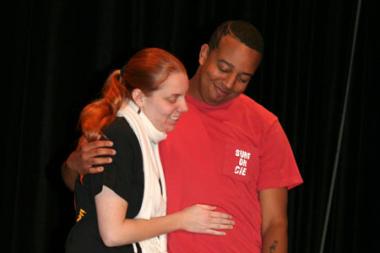When actors are preparing to play a role, they often dig into the character’s “back story”—the life history that brought that person to the moment s/he appears on the stage. The playwright often provides at least some of it in the script, but what’s written on the page is the here and now. It’s the actor’s job to dig deeper, to use imagination to fill in the blanks to better understand the character’s motivations and personality.
Joan Ackermann’s “Back Story” does just the opposite. In that short story, the Berkshire-based playwright traces the lives of sister and brother Ainsley and Ethan Belcher from birth to early 20s. The play of the same name comprises a series of short scenes drawn from that narrative.
Back Story the play is itself an experiment in playmaking. Eighteen playwrights, including Ackermann, were commissioned by the Humana Festival of New American Plays to each contribute a monologue or two-person vignette based on Ackermann’s scenario. The 19 scenes (Ackermann wrote both the first and last) trace the siblings’ story, each one zeroing in on a particular theme or narrative moment. The result is an episodic journey that doesn’t actually follow on from Ackermann’s back story, but instead expands on its incidents.
The story is set in the Berkshires—not the leafy gentility of Lenox or Stockbridge, but working-class Pittsfield—in the 1980s and ’90s. We see Ainsley and Ethan as teenagers and young adults, with references back to earlier chapters in their biographies. Ethan is a dud at school, virtually illiterate, but an ambitious youngster driven by an “uncontrolled velocity” to achieve at a variety of ventures, from TV repairman to guide at Herman Melville’s historic house. Ainsley finds her purpose in looking after her disorderly younger brother and making music.
This weekend’s performances of Back Story employ 18 actors, all students at American International College, portraying the two characters in the various scenes. Fred Sokol, Director of Theater Arts at AIC, calls the undertaking “a challenge. It’s a play with many different voices. In a way, this is experimental theater. There isn’t a through line. But the concept won me over.”
Sokol, a former theater critic for the Springfield Republican, was recruited to AIC in 2007 by its president, Vincent Maniaci, to revive the school’s moribund drama club, the Garret Players. Since then he has staged two shows a year, including productions just as adventurous than this one, such as Tina Howe’s multidisciplinary folktale East of the Sun and West of the Moon and Horton Foote’s sprawling family epic Dividing the Estate.
Sokol says his actors in Back Story—”some of them as talented as any others on the college level, some who have not performed before, and everyone in between”—have particularly responded to the play’s local setting, with its references to hilltown sites and the Holyoke Mall. “It enables this group to relate, imagine, embody.”
Before the opening night performance, AIC communications professor Mary Ellen Lowney will give a reading of Ackermann’s original story, with video replays before succeeding performances. Audiences thus have the option of seeing the play “in context” or to experience it on its own as a freestanding theater piece.
Back Story: Nov.19-21, free, Griswold Theatre, Karen Sprague Cultural Arts Center, American International College. Not recommended for young children. (413) 205-3264.



